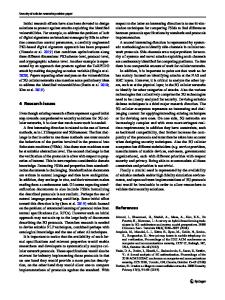Position, Navigation, and Timing for Security
Global Navigation Satellite Systems (GNSS) allow users to compute their position, velocity, and time anywhere in the world, anytime, and with a high accuracy. The best known and most popular GNSS is the US Global Positioning System (GPS), far in front of
- PDF / 33,730,801 Bytes
- 1,587 Pages / 439.42 x 683.15 pts Page_size
- 37 Downloads / 284 Views
ndbook of Space Security Policies, Applications and Programs Second Edition
Handbook of Space Security
Kai-Uwe Schrogl Editor-in-Chief
Maarten Adriaensen • Christina Giannopapa • Peter L. Hays • Jana Robinson Section Editors
Ntorina Antoni Managing Editor
Handbook of Space Security Policies, Applications and Programs Second Edition
With 248 Figures and 47 Tables
Editor-in-Chief Kai-Uwe Schrogl European Space Agency (ESA) Paris, France Section Editors Maarten Adriaensen European Space Agency (ESA) Paris, France
Christina Giannopapa European Space Agency (ESA) Paris, France
Peter L. Hays Space Policy Institute George Washington University Washington, DC, USA
Jana Robinson Space Security Program Prague Security Studies Institute (PSSI) Prague, Czech Republic
Managing Editor Ntorina Antoni Eindhoven University of Technology Eindhoven, The Netherlands
ISBN 978-3-030-23209-2 ISBN 978-3-030-23210-8 (eBook) ISBN 978-3-030-23211-5 (print and electronic bundle) https://doi.org/10.1007/978-3-030-23210-8 1st edition: © Springer Science+Business Media New York 2015 2nd edition: © Springer Nature Switzerland AG 2020 All rights are reserved by the Publisher, whether the whole or part of the material is concerned, specifically the rights of translation, reprinting, reuse of illustrations, recitation, broadcasting, reproduction on microfilms or in any other physical way, and transmission or information storage and retrieval, electronic adaptation, computer software, or by similar or dissimilar methodology now known or hereafter developed. The use of general descriptive names, registered names, trademarks, service marks, etc. in this publication does not imply, even in the absence of a specific statement, that such names are exempt from the relevant protective laws and regulations and therefore free for general use. The publisher, the authors, and the editors are safe to assume that the advice and information in this book are believed to be true and accurate at the date of publication. Neither the publisher nor the authors or the editors give a warranty, expressed or implied, with respect to the material contained herein or for any errors or omissions that may have been made. The publisher remains neutral with regard to jurisdictional claims in published maps and institutional affiliations. This Springer imprint is published by the registered company Springer Nature Switzerland AG. The registered company address is: Gewerbestrasse 11, 6330 Cham, Switzerland
Introduction
Never before has security in space been more challenged. Never before has space been more elaborately used for military and security purposes on Earth. And never before was it more necessary to understand and to receive orientation in the policy area of space security. This indeed is the purpose of this second edition of the Handbook of Space Security, which is addressed to all persons and institutions dealing with space security on a governmental, academic, societal, international, and diplomatic level. From now, the global future will depend on the secu











